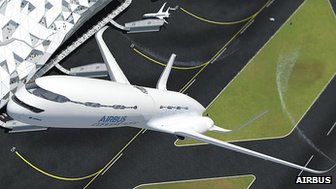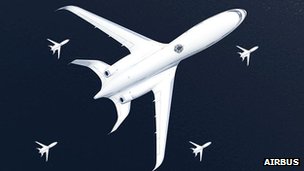.
Airbus details Smarter Skies vision for planes in 2050
.

Airbus says a steeper climb would make take-offs less noisy and could shave minutes off flight times
.
Aeroplanes that take-off and prepare to land at much sharper angles than they do at present are among Airbus' latest industry forecasts.
The European jet-maker made the predictions in its Smarter Skies vision for air travel in 2050.
The firm said the moves could minimise noise, reduce fuel emissions and potentially shorten flight times.
It added that shorter runways could be used, helping reduce the amount of space airports need.
That marks a contrast with the firm's recent launch of the A380 "sumperjumbo" which - along with Boeing's older 747 design - takes advantage of the length of the runways commonly found at today's large hub airports.
Gliding jets
Airbus suggested a propelled platform with its own set of wheels placed beneath the aeroplane's fuselage could help boost its acceleration before detaching just before take-off.
It said this would make a steeper climb possible, and in turn allow jets to reach cruise altitude in less time.
At the other end of the journey it suggested planes could glide towards airports using a steeper approach than is common at present as an alternative to the use of engine thrust and air brakes.
It said this could slow aircraft at an earlier stage, making shorter landing distances possible.
"As space becomes a premium and mega-cities become a reality, this approach could... minimise land use, as shorter runways could be utilised," it added.
One analyst agreed that environmental pressures were likely to lead to change, but questioned whether Airbus' vision would prove true.
.

Airbus suggests that flying in formation could cut air drag and thus boost fuel efficiency
.
"Shorter runways would certainly require some more radical - and likely expensive - technological developments," said John Strickland, from JLS Consultancy.
"We have new larger aircraft like the Airbus A380 and smaller like the Boeing 787 Dreamliner. They offer longer range but that in itself tends to reduce opportunities for shorter take offs.
"I'd tend to be a bit sceptical of whether we will actually see this development as envisioned."
Other suggestions made in the Smarter Skies document included:
The use of software to select routes that make the best use of weather conditions to cut fuel use.
Planes flying in formation to take advantage of reduced drag making them more energy efficient.
The use of biofuels, solar power and hydrogen as alternative sources of power.
.
Quelle: Airbus
5499 Views

